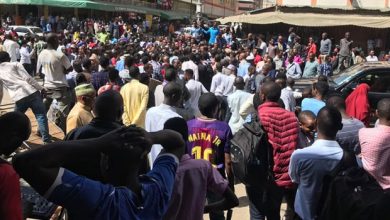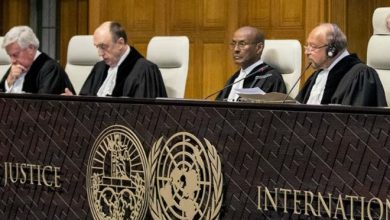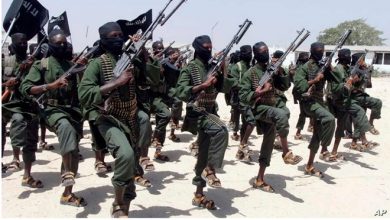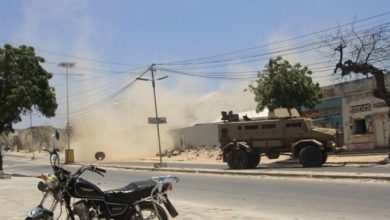Revealed: The CIA and MI6’s secret war in Kenya
A covert Kenyan paramilitary team armed and trained by the US and supported by UK intelligence is behind renditions and controversial killings of terror suspects, the Star can reveal
A covert Kenyan paramilitary team armed and trained by the US and supported by UK intelligence is behind renditions and controversial killings of terror suspects, the Star can reveal
An investigation conducted by Declassified UK, Daily Merverick in South Africa and the Star revealed how a clandestine Kenyan team has been paid and assisted by the CIA to take down terror suspects since 2004.
Britain’s MI6 also plays a key role in identifying suspects for a ‘kill or capture’ list and finding and fixing their location.
The investigation further reveals that paramilitaries use covert tactics such as fake number plates and disguise themselves as aid workers on operations in refugee camps, which “shield perpetrators of abuses from any shred of accountability”.
The commandos who raided have been raiding homes of suspected terrorists belong to the Rapid Response Team (RRT), a clandestine ‘special team’ of the Kenyan paramilitary General Service Unit’s Recce Company. The RRT was set up, equipped, trained and is guided on tactical counter-terror operations by America’s Central Intelligence Agency (CIA), a Declassified investigation can reveal.
The secretive Kenyan team is informally known as the Rendition Operations Team and is composed of around 60 police commandos.
The CIA’s covert programme, which began in 2004, is managed by a paramilitary liaison officer at the US embassy in Kenya’s capital Nairobi, but has until now successfully avoided public scrutiny.
A covert war
Based on interviews with over two dozen CIA, US State Department and Kenyan intelligence, paramilitary and police officers, this investigation has found that in its 16 years of operation, the CIA-backed team has been responsible for the capture of high-value terror suspects, as well as rendition operations, killings and alleged summary executions.
The creation of the RRT was “an indigenous solution to an indigenous problem”, a former senior CIA counter-terrorism official told this investigation.
“Our leadership at CTC [CIA Counterterrorism Center] and others felt that setting up these units was important: it was something that gives value to the partnership and it puts a unit under our control for when we have targets that we feel need to go down.”
Often, the paramilitary team’s raids are driven by intelligence provided by the CIA itself, as well as Kenya’s National Intelligence Service (NIS).
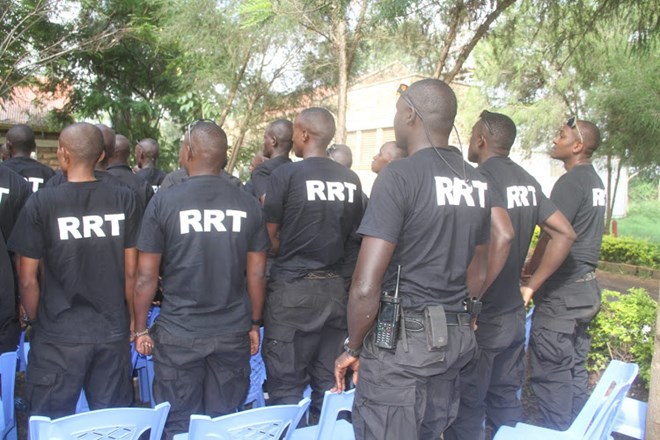
CIA-backed RRT paramilitaries particiapte in a Christmas ceremony in 2019 during a visit from the Kenyan police Inspector Genetal and other senior police officers. (Photo by: Kenyan National Polce Service)
However, multiple current and former US and Kenyan diplomatic, intelligence and police sources said that Britain’s Secret Intelligence Service (SIS, better known as MI6) plays a key role in identifying, tracking and fixing the location of targets, as well in decisions determining their fate: kill or capture.
The American and British governments provide covert support to Kenya in order to help it defeat al-Shabaab, an al-Qaeda-linked group that has carried out dozens of deadly attacks in Kenya.
Its most high profile atrocities have been on Nairobi’s Westgate shopping mall in 2013, where it killed 67 people and on Garissa University in 2015 which killed 148 people.
Al-Shabaab and its sympathisers are also behind a number of high-profile abductions and attempts to kill foreign dignitaries, including a plot to bomb then-Secretary of State Hillary Clinton during a visit to Kenya in 2009.
Former deputy chief (operations) of the CIA’s Counterterrorism Center, Henry Crumpton explained the nature of the war on terror in Kenya. “It’s a different type of conflict, a different type of war. And it is intelligence-driven.”
Crumpton, who led the CIA’s war in Afghanistan in 2001, continued, “I think that’s why the CIA really has had the lead in many areas, long before any others, because the CIA was there and the CIA was providing value to those partners and the operations, whether they are diplomatic or law enforcement or military, even economic, all those instruments of statecraft, they’re all informed and driven by the intelligence. That’s the foundation for this conflict.”
Khelef Khalifa, chair of human rights organisation Muhuri, said: “When these extrajudicial killings happen, Muslims feel they are under siege because they cannot comprehend why the government cannot arrest these people and take them to court, instead of killing them.”
Intent on remaining in the shadows, once suspects are “neutralised” – killed or captured – the plainclothes commandos of the RRT hand control of the operation to local police; typically Kenya’s Anti-terrorism Police Unit (ATPU). In doing so, the RRT successfully avoids scrutiny – let alone accountability – for operations now spanning over a decade.
So, too, does its American backers.
Mistaken killing
Defenders of the RRT say it has been instrumental in neutralising the threat from al-Shabaab. While the Kenyan and international press have made no mention of the RRT’s central role in counter-terrorism operations, multiple US and RRT sources confirmed that the CIA-supported team played a lead role in successfully neutralising the Garissa and DusitD2 attackers.
According to a Kenyan officer briefed on the operation, on the night of the raid the team was, in fact, hunting for Fuad Abubakar Manswab, the alleged mastermind of a foiled 2011 terror attack in Mombasa, whom authorities believed to be hiding in the neighbourhood.
Manswab was thought to be “armed and dangerous and someone who can engage and kill,” the officer said, noting that “he escaped a prior operation with a wound”. So the RRT were instructed to “eliminate” him.
Kill or capture
Current and former members of the RRT stressed their objectives prioritise capture over killing. However, they all confirmed that any perceived threat or resistance from targets is to be met with lethal force.
“I don’t have to shoot if I don’t see your hand”, a RRT officer said, describing the team’s rules of engagement. “Because the hand is the most dangerous part…But if you have something in your hands, I don’t have to spare you because you mean danger to me.”
Sometimes, though, targets are taken alive.
In 2010, Police kidnapped and rendered the suspected militants behind the al-Shabaab-inspired bombings of a rugby club and restaurant in Kampala, Uganda, to face interrogation by American, British and Ugandan agents.
Though Kenya’s ATPU was widely blamed for the renditions, multiple police and paramilitary sources confirmed that RRT operatives undertook some of them, in addition to renditions from Somalia in the years before.
A sturdy by the Independent Medico-Legal Unit, a non-profit organisation that monitors misconduct by law enforcement, recorded 1,873 gun deaths in six urban areas in Kenya between 2009 and 2014. It found Kenyan police were involved in nearly two-thirds of the cases, many of them execution-style killings.
More recent IMLU figures show a decline in extrajudicial executions in the last five years but they still amount to over 100 per year.
The RRT does not account for the bulk of these alleged extrajudicial killings in Kenya, both US officials and RRT officers stressed, since its role is dedicated to targeting high-value or high-risk terror targets. But when suspects disappear or turn up dead, the Kenyan government rarely undertakes a formal investigation.
According to Maria Burnett, former East Africa director for Human Rights Watch, out of hundreds of extrajudicial killings that have taken place during counter-terrorism operations in recent years, “only a small handful” had been seriously scrutinised.
In Faraj’s case, the Kenyan government never acknowledged its role in his death, instead claiming that security forces killed “terrorists” after being fired upon. It was similarly unabashed about the fate of Titus Nabiswa, the police informant who led the commandos to Faraj’s house that night and whose body was later found dumped, killed by a gunshot wound to the head.
The US hand
Housed at a secretive base in the town of Ruiru, roughly 30 kilometers east of Nairobi, the ranks of the Rapid Response Team (RRT) have thinned in recent years as some members have decamped for Kenya’s burgeoning private security sector, which offers better pay and working conditions.
To counter these temptations, the CIA’s paramilitary liaison to the RRT provides regular financial support, including allowances for operations and bonuses for successful missions.
This is designed to supplement the low wages of Kenyan police officers . Injured operatives are given cash payouts and treatment at Nairobi’s private Aga Khan hospital. RRT officers call these “motivation packages”.
While the amounts have varied over the years, RRT officers confirmed receiving the equivalent of a 30% “boost” to their salaries per month, paid for by the US embassy.
The RRT also receives weapons and equipment from the CIA. Initially supplied with M16 assault rifles, then M4 carbines, they have also received Glock pistols, M79 grenade launchers, body armour, helmets and M67 and Stinger CS grenades.
The RRT’s operations appear to need sign-off from the US. Multiple RRT sources independently confirmed that the team is not to be deployed by its Kenyan command for tactical anti-terror operations without the knowledge and consent of its US embassy handlers. The exceptions are for rapid response to high-profile terror attacks, such as the Westgate mall and DusitD2 attacks, and for the diplomatic protection of foreign dignitaries.
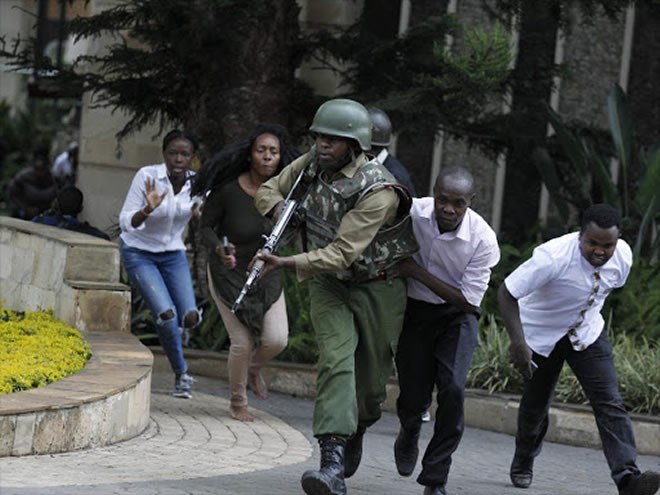
A security officer helps evacuate survivors from Dusit Hotel after a terrorist bomb attack on January 15, 2019. Photo/ Monicah Mwangi
Since 2004, the CIA has paid for RRT commandos to fly to the US for SWAT-style training in rendition and disruption operations, including reconnaissance and surveillance, storming a building, close-quarter battle, and weapons handling at locations that include Annapolis Naval Academy in Maryland.
But the US role goes further. The CIA paramilitary liaison, based at the US embassy in Nairobi, is directly involved in planning some of the RRT’s operations.
Occasionally, CIA operatives themselves have participated in operations, US officials and Kenyan RRT officers confirmed. “If they really, really want the results, they will even assist directly,” one mid-ranking Kenyan paramilitary officer said.
CIA paramilitary officers and contractors have also assisted the RRT by conducting surveillance and tracking of a target, either remotely or from a nearby safehouse or vehicle. However, even as they observed operations unfolding, they maintained a careful distance, RRT officers said.
Britain’s role
Working closely with its counterparts at the Counterterrorism Unit of Kenya’s National Intelligence Service (NIS), the CIA identifies suspects and prepares target packages – intelligence and analysis on a given suspect – that include actionable intelligence.
Together they decide a given target’s fate in a so-called “disposition matrix” that includes options ranging from arrest to using lethal force, according to the former senior US official based in Africa.
In 2015, then CIA director John Brennan told an audience, “We exchange information with our counterparts around the world to identify and track down men and women believed to be violent extremists… Our cooperation with foreign liaison quietly achieves significant results. Working together, we have disrupted terrorist attacks and rolled back groups that plot them.”
In formulating the target packages, CIA officers in Nairobi also work closely with their counterparts at MI6, Britain’s foreign intelligence service, which relies on its long-standing human intelligence network to provide actionable intelligence by finding and tracking targets and infiltrating militant circles.
MI6 boasts a specialism in human intelligence, tracking and infiltration operations. Such capabilities are often relied on by the CIA in Kenya and other covert counter-terrorism operations, such as in Yemen, two former senior US officials confirmed.
Leaked US diplomatic cables show that for over a decade Kenya’s intelligence service, NIS, has had “primary responsibility for CT [counterterrorism]” in the country. As lead agency, NIS is the principal beneficiary and conduit of the bulk of CIA and MI6’s efforts in Kenya, former senior CIA and State Department officials confirmed.
“They [NIS] were the meat and potatoes of everything we did”, the former senior State Department official said. “The police didn’t have much of an intel capability. Actionable information always flowed through the intelligence service.”
Unlike the CIA, actionable intelligence from MI6 does not reach the RRT paramilitaries directly, but through its CIA and NIS counterparts.
‘ARCTIC’
As well as working with the CIA on target development, MI6 also collaborates with a dedicated team of Kenyan intelligence officers, as part of a liaison cell within NIS’ Counter-terrorism Unit, codenamed ARCTIC, multiple Kenyan and US intelligence officials confirmed.
At times, the NIS ARCTIC cell works directly with RRT operatives in finding targets and fixing their location before sending in the RRT.
One of MI6’s targets included British national Jermaine Grant. Grant had sneaked back into Kenya after, allegedly, receiving paramilitary training in Somalia and was an associate of British terror suspect Samantha Lewthwaite, dubbed the ‘White Widow’.
As a British national, killing Grant would have focused scrutiny on the relationship between Britain and Kenya’s security forces. So in 2011, RRT officers, guided by NIS ARCTIC agents working in collaboration with MI6, led an operation intent on capturing him, two Kenyan officers familiar with the operation confirmed.
One Kenyan officer explained, “The Recce [RRT] and NIS were ahead of us. They arrested [him], they took away his flash disk and his purse [wallet]. After some time, they brought him to the police station but they didn’t book him in. They came and he was in the boot of the car outside the police station.”
But not all MI6 targets are as fortunate as Grant, who is now serving a 13-year jail term in after being convicted for possessing bomb-making material and using forged documents to obtain Kenyan citizenship.
Two years later, in June 2013, RRT commandos would kill Kassim Omollo, an alleged al-Shabaab trainer, bomb expert and an accomplice of Grant, in another pre-dawn raid. Omollo had allegedly slipped back into Kenya from Somalia and was maintaining a low profile at his family home in Mombasa.
‘Hands-on’
Often it is the CIA’s liaison—an officer in the agency’s paramilitary Special Activities Center (SAC) Ground Branch—who feeds the actionable intelligence to the RRT commandos, either directly or through the NIS.
One former liaison officer was known to the Kenyan operatives as “Matt”, said one RRT officer, who described him as a “down-to-earth guy who would sit with the guys and talk to them”. The officer added, “Matt made us form a family and we were really a family”.
Far from being exceptional, Matt’s approach reflected the CIA’s broader attitude towards its liaison partners, a former senior US State Department official confirmed. “When we support these kinds of units we’re really hands-on. We don’t just hand them the money once a month.”
The RRT commandos who worked with Matt explained that his CIA counterpart would prepare the team through the General Service Unit-Recce-RRT chain of command in advance of orders issued by Kenya’s Inspector General of police.
Commenting on US support to the RRT, former US ambassador to Kenya, Michael Ranneberger, who left office in 2011, said, “That kind of support is critical to making them a professional force. If you’re really trying to set up a professional unit that will respect human rights and be effective in carrying out its operations, our support is critical.”
While neither the US government nor the US embassy in Nairobi has previously commented on its role in supporting the Kenyan commando team, former CIA director John Brennan did admit to knowledge of abuses by partners.

Special forces make their way into DusitD2 hotel and complex./ COURTESY
Avoiding detection
For 16 years, RRT operatives have managed to avoid detection and public scrutiny. Multiple RRT officers, who operate in plainclothes when on tactical counter-terror assignments, admitted using unmarked cars hired from private companies and swapping between private or unregistered number plates, in order to avoid identification.
A single RRT vehicle typically carries at least three plates which are swapped at least once on operations, upon departure from a target’s location.
The vehicles used vary but former RRT officers confirmed that the US had supplied a stock of at least six white Toyota Landcruisers (76 model), specially ordered with blacked-out windows and a custom cabin to accommodate the commandos’ needs.
Kenyan officers conducting surveillance in urban areas sometimes also appear in less conspicuous Toyota Premio sedans, while in high value operations, their CIA handlers would occasionally join them but remain at a safe distance in black, fully tinted Landcruiser Prado SUVs (J120 model).
Declassified has also learned that since 2004, RRT operatives have disguised themselves as aid workers when on operation in refugee camps such as Dadaab in eastern Kenya or Kakuma in the northwest.
In Dadaab, concerned by al-Shabaab’s infiltration of the camps, weapons smuggling and attack plans on Kenyan soil, the officers used United Nations World Food Programme (WFP) vehicles and wore WFP t-shirts while posing as aid distributors, as they sought to identify those suspected of bringing in weapons and collaborating with the militant group.
Once the suspects had been identified, and reports filed on the targets, a second team would then be sent in to “mop up” and neutralise the targets, a former RRT officer familiar with the operations said. Declassified understands that the RRT continues to send undercover officers to the camps on rotation.
A UN WFP spokesperson said the agency had no knowledge of the covert operations within the refugee camps. The UNHCR, which administers the camps, did not answer questions as to whether it had any knowledge of or involvement in facilitating the covert operations, instead noting that the Kenyan government retained responsibility for their security. The Kenya Police Service, under which the Recce Company RRT falls, did not answer requests for comment.
In another raid, on 18 May 2013, RRT operatives surrounded an apartment building outside Nairobi, according to an officer with knowledge of the operation. The target and his wife were killed after they violently resisted capture, a police spokesman would claim, and their baby was taken into custody.
The man killed was later named as Hassan Omondi Owiti, a terror suspect the police had allegedly been trailing for months. Also killed was his wife, Shekha Wanjiru.
Successes
Current and former senior US officials with knowledge of the CIA programme in Kenya pointed to the RRT’s success in disrupting attacks.
The year 2018 witnessed one of the lowest death tolls from terror attacks in the past decade in Kenya. And while 2019 witnessed a 20% increase in casualties on the year before, the bulk of this difference was due to a single incident: the DusitD2 attack. On the whole, and with significant assistance from the CIA, Kenya has made substantial strides in disrupting terrorism.
However, while al-Shabaab’s attack on DusitD2 claimed fewer casualties than the earlier Westgate and Garissa attacks, experts described the raid as “representing a new and dangerous phase in the group’s evolution”, since it was the first major operation relying on Kenyan nationals of non-Somali descent.
Capitalising on the DusitD2 attack, in September 2019 al-Shabaab car bombers hit US and European military bases in Somalia. While the operations missed their targets, within two months a group of UN experts declared that al-Shabaab’s use of improvised explosive devices reached its “greatest extent in Somali history”.
For critics of the West and Kenya’s war on terror, recent events are ominous. “We are being hit all the time. Because we are being seen as pro-American, pro-West”, former Kenyan vice president Kalonzo Musyoka said. “It’s not a matter of if, but a matter of when we get attacked again. For as long as we have our troops inside Somalia.”
All US diplomatic and intelligence sources interviewed by Declassified expressed concern about Kenya’s abuses in the war on terror. Nonetheless, former US ambassador William Bellamy, who served in Nairobi from 2003-06, said that American-backed teams like the RRT should be “safeguarded and preserved”.
“That is the kind of CT [counter-terrorism] relationship where you feel your partner is accountable and responsive and where you have some correlation between your inputs and their outputs that you can point to”, he said.
But others say that in addition to flouting Kenyan law, the killings carried out by the RRT — and the culture of impunity it exemplifies — can breed extremism.
Namir Shabibi is a British investigative journalist who has written and produced documentaries for the BBC, VICE News and The Bureau of Investigative Journalism, among others.
Declassified UK is an investigative journalism organisation that covers the UK’s role in the world.


